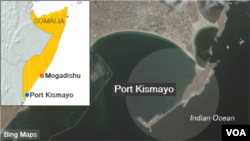NAIROBI —
As Kenyan troops close in on the al-Shabab militant stronghold of Kismayo, Somalia, United Nations officials are urging armed forces to try to minimize civilian casualties.
U.N. Humanitarian Coordinator for Somalia Mark Bowden met with the Kenyan defense minister and military officials in Nairobi Wednesday to discuss ways to protect civilian lives as the military operation heats up around the port city.
Bowden said there has been a spike in the number of civilians fleeing the coastal city, one of the Somali militant group's last remaining bastions.
“At the moment there appears to be a level of panic or concern about military operations, and yesterday we recorded over a thousand people leaving Kismayo," said Bowden, explaining that plans for providing humanitarian access to those in need must be made as soon as possible.
“At the moment there appears to be a level of panic or concern about military operations, and yesterday we recorded over a thousand people leaving Kismayo," said Bowden, explaining that plans for providing humanitarian access to those in need must be made as soon as possible.
Al-Shabab Timeline
Al-Shabab Timeline
2006: Launches insurgency to topple Somali government, impose Islamic law
2008: U.S. declares al-Shabab a foreign terrorist organization
2009: Seizes control of parts of Mogadishu, Kismayo
2010: Expands control across central and southern Somalia; carries out deadly bombings in Kampala, Uganda in first attack outside Somali
2011: Blocks drought/famine aid from areas under its control
2011: East African leaders declare al-Shabab a regional threat, Ethiopian, Kenyan troops enter Somalia to pursue the group, which is driven out of Mogadishu
2012: Declares itself an al-Qaida ally, loses ground in Somalia, troops advance on the group's stronghold Kismayo
“The concern is that their interests are safeguarded and hopefully we can then make sure these people don't become long-termed displaced populations, and are able to return to safety as soon as possible," he said.
Accounts of civilian casualties
Accounts of civilian casualties
According to Kenyan military officials, ships have been shelling al-Shabab targets in Kismayo, and receiving return fire from militants, in the past few months. U.S.-based Human Rights Watch urged Kenya to investigate an August shelling incident in which two children and a pregnant woman were killed.
Although Kenya's military was integrated with African Union forces (AMISOM) in June, its naval ships continue to operate independent of the AMISOM mission.
Kenyan military spokesman Colonel Cyrus Oguna said that, in operating independently, Kenyan forces are doing nothing illegal.
“We're not entirely banned from using maritime forces as long as it's in line with our national interests," he said. "So yes, that's why we're using maritime forces [to shell Kismayo], including air forces. As long as we're using it to protect our national interests and we're also taking care of collateral damage, we have not broken any law whatsoever.”
“We're not entirely banned from using maritime forces as long as it's in line with our national interests," he said. "So yes, that's why we're using maritime forces [to shell Kismayo], including air forces. As long as we're using it to protect our national interests and we're also taking care of collateral damage, we have not broken any law whatsoever.”
Oguna also said Kenyan and Somali forces captured the town of Jana Cabdalla, which is within 50 kilometers of Kismayo, on Wednesday.
A fight to the death
Military officials and witnesses have said al-Shabab commanders have been fleeing Kismayo this week, but that some fighters may be staying behind to defend the city.
VOA Somali service reports an al-Shabab radio transmitter dismantled earlier this week in Kismayo is again up and running, broadcasting the group's message and urging residents to stay calm, but vowing to fight to the death.










